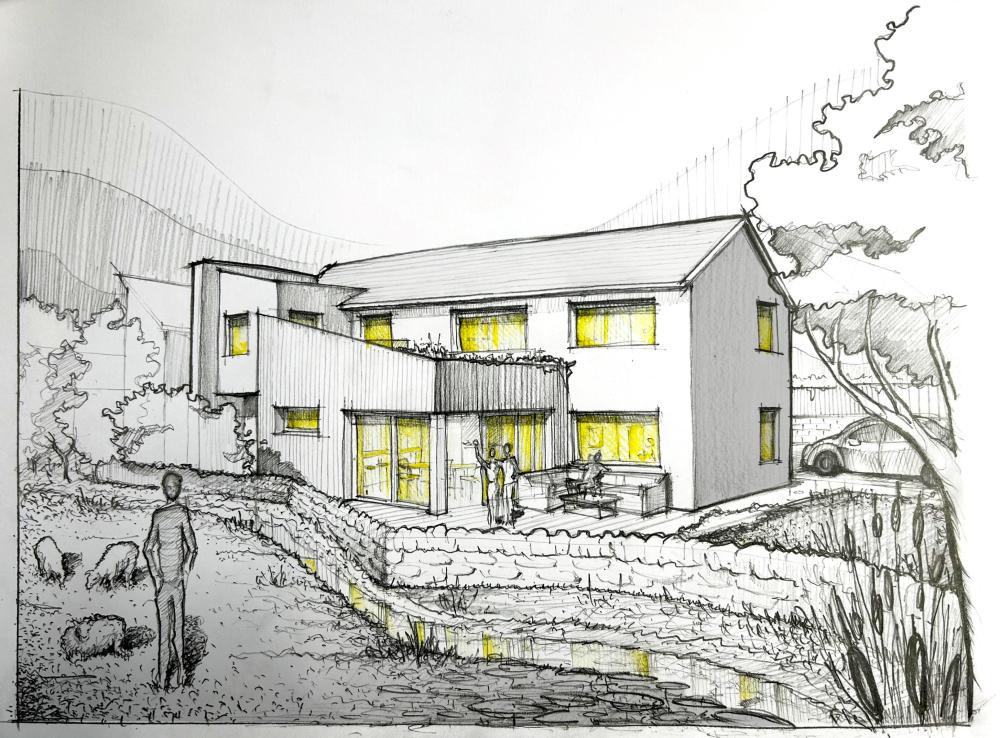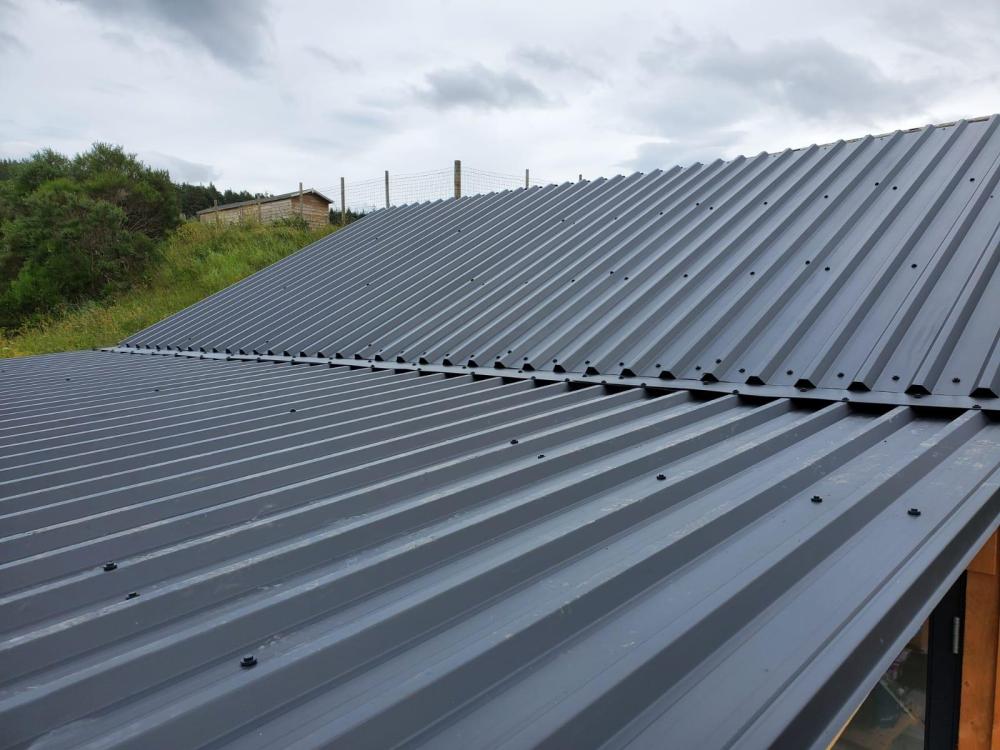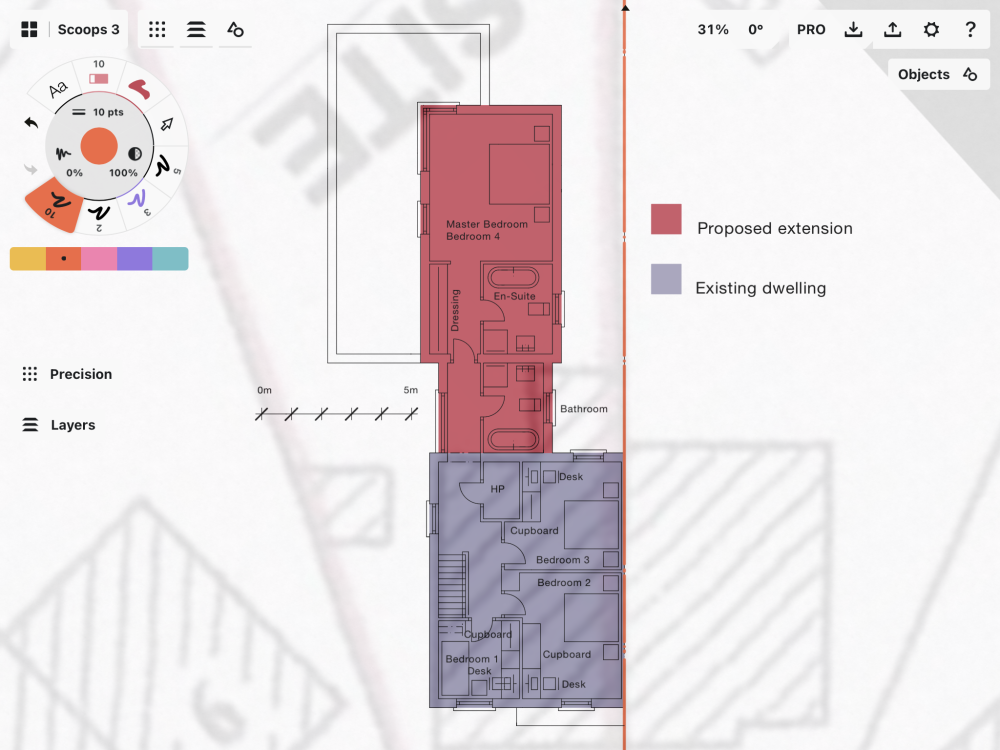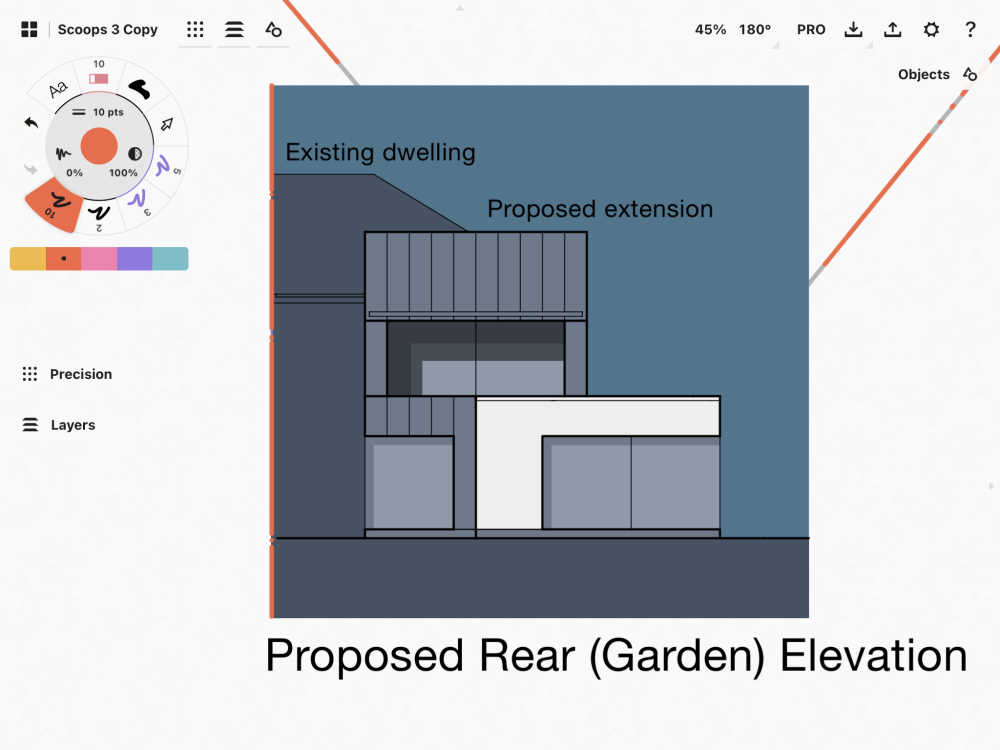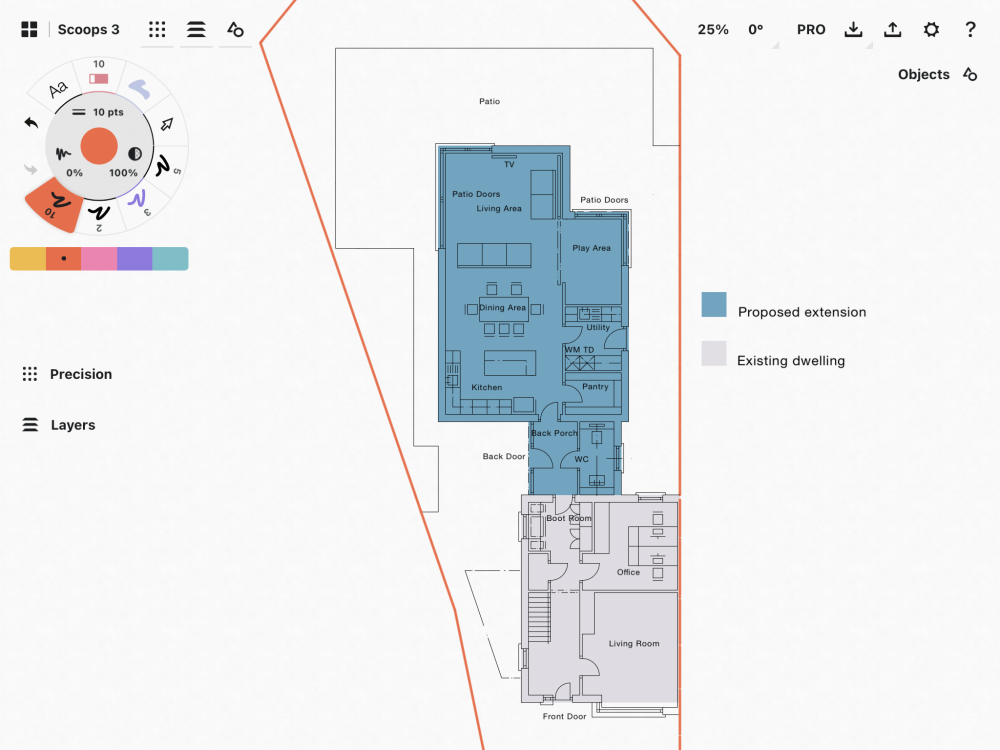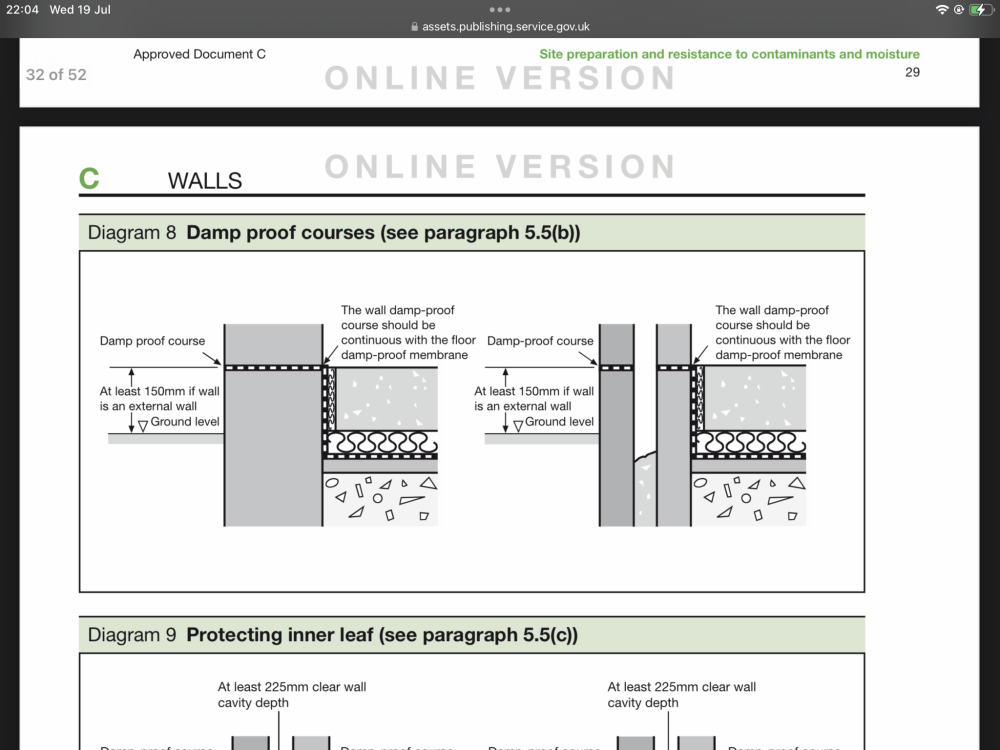Leaderboard
Popular Content
Showing content with the highest reputation on 07/21/23 in all areas
-
@Thorfun @AliG Thanks for your comments. Watch this space - amended version coming soon.2 points
-
2 points
-
Wallz. Yes, unmoulded planks of spruce, hit and miss then overboarded. Roof. I haven't inspected it yet but have told them to add more screws at corners as the wind force will be far more there. In storms it is always flashings that come loose. This cladding came from a supplier in inverness that we didn't know of in time for the house roof.2 points
-
+1, keeping the chain sharp by just a little sharpening every now and again keeps it most efficient, no point in running it into the ground and needing a chain replacement, just makes it hard work and overworking the rest of the machine.2 points
-
Yep exactly. The critical error is the drop in the wall. They simply needed to follow the course of blocks form the utility all the way around. The only thing I would accept as a resolution has now been agreed. They are going to lift the frame up, build the course of blocks with damp on top and then set the frame back on top. How it should have been done from the start.1 point
-
The conditions should have been included with the officer's recoommendation, and thus were approved. Otherwise, it wasn't really concluded. If you could just find the agenda papers or minutes. Keep trying.1 point
-
I don't think you can reclaim VAT on a reduced rating project, you can only pay 5% to service providers. It is not entirely clear looking at the rules.1 point
-
Hi guys thanks for the replies, yes it's an existing conservatory inherited from the previous owner. Making a form with PIR board and then layup would seem favorite at present, could you go into more detail1 point
-
Yes. But nothing to stop a second layer going over the top. That is one of the beauties of GRP, you can hack it about and then stick more on.1 point
-
It is a shame, but the sole plate may rot out very quickly with the detail that has been built. They need to remove what they have done on this section, build up the masonry, then reinstate.1 point
-
Hmmmm.... I am very skeptical of shrinkage or thermal cracking being the cause. Cracks in masonry can only occur under tension (or tension caused by shear). That must mean there is some movement orthogonal to the line of the crack. The mechanism of shrinkage does not cause horizontal cracks on short returns. Similarly, thermal movement cracking would be at the interface of a long panel and a short panel, not wholly within a short panel. Were they a Chartered Engineer? However, overall I don't think it is anything to be much concerned with. Likely minor settlement of the three story building immediately adjacent pulling the bottom half of the shorter wall with it. Repair and keep an eye on it.1 point
-
1 point
-
Would have to look at the underlying data and assumptions. Do people in old draughty houses have colder houses? If the assumption is that all houses have a mean internal temperature of 20⁰C, but F and G are in the real world 18⁰C. Then the assumption is right, but the data may be misleading.1 point
-
Have a look at this video from 9:50. I wish we'd done it in our house.1 point
-
you could use the twin wall polycarbonate sheets. my friend did his with the opaque sections they use in industrial units. they are an off white creamy colour that let light through but wont melt you like a conservatory roof if its sunny.1 point
-
Ask who ever is signing off your house what paperwork they normally require from the plumber. I suspect they'll be confused by the question. So long as your place complies with the building regs it's unlightly anyone will ask for anything beyond that. The one thing I would get a plumber for is the gas connections for a split unit ASHP. Everything else I would be happy to DIY. I redid all our DHW after the plumber made a mess of it. As for insurance I would far prefer to put my money into a good install and a really redundant design. Ensure that every room where a pipe is jointed has a floor drain. You're half way there with wet room showers. That way if a fitting fails when you're away for the weekend you'll just have to turn off the stopcock, mop slightly wet floor and replace a tap or T joint. Far easier than chasing an insurance company for months to remodel the whole house.1 point
-
Use a std AC to DC battery charger to put the juice into the batteries, then an off grid DC to AC inverter to take the power out of batteries. The charger can be on the DNO side as its incapable of feeding AC into the grid but the off grid inverter can only be used when the mains is isolated. The quality of the AC from the off grid inverter needs to be good enough for the Solis/Growatt to think they are grid connected and so you can still utilise the PV output during a power cut. Choice of off grid inverter will depend on the type of battery chemistry and voltage plus confirmation grid tie inverters will be fooled.1 point
-
1 point
-
We project managed our build. We made a point of asking each contractor (once we were happy with their work) to recommend trades people for the next stage.1 point
-
the only part exposed is the centre join if you have multiple panels side by side. Everything else is flashed.1 point
-
1 point
-
Powering boilers with renewable hydrogen uses six times more renewable energy than the renewable energy used for heat pumps. You can't beat the second law of thermodynamics. To get heat from renewable hydrogen, you have to generate electricity from solar or wind, convert it from AC to DC, electrolyse water to produce the hydrogen, compress and transmit it and then burn it in a boiler. Each of those steps has unavoidable losses. To get heat directly from renewable electricity, you cut out all of those losses apart from transmission, but then multiply it up by the SCOP in your heat pump. It makes no sense at all to burn hydrogen in a boiler and moreover, because of the inefficiencies, hydrogen will unavoidably be much more expensive than electricity running a heat pump. To heat our homes with renewable hydrogen, our off shore wind generating capacity will have to be 40 times larger than it currently is. To heat our homes with renewable electricity and heat pumps, it only needs to be 6.5 times larger. Hydrogen will play a key role in decarbonisation, but we should prioritise its use for applications where there is no alternative. For heating and transportation, the alternative is electricity. But there are no alternatives to industrial uses such as producing ammonia (used e.g. to make fertilisers) and producing methanol (used e.g. to make paints and adhesives). At the moment those processes get their hydrogen from natural gas and release CO2. One thing I can agree with the politicians about, is that the UK has a large energy resource in North Sea off shore wind. This is a great opportunity but we should use it wisely - to heat our homes, power our cars and yes, produce hydrogen, but to bring back some of the well paid chemical industry manufacturing jobs which have been lost over the last 50 years. Government support for hydrogen in domestic heating will just increase the cost of getting to net zero and is a distraction which will cause delays. They need to think more about how to make it financially attractive for people to install heat pumps. Decoupling the price of electricity and gas would be a good start - as long at electricity is three times the price of gas, there's no incentive to incur the extra costs of a heat pump.1 point
-
1 point
-
I've just replaced a bitumen roof on the chicken run with Suntuf corrugated polycarbonate sheets, they seem better than the really cheap ones, though they do need a fair amount of support1 point
-
1 point
-
1 point
-
I want it replaced. Given all the shit I have had to sort out because of their incompetence I’m not accepting something that could be fixed.1 point
-
when I've got the solution, I'll blog the install and stand back for the replies...1 point
-
Can you take loads of pictures please as this issue comes up quite often.1 point
-
I use timers. The good ones give a lot of timing options, and you can adjust the tap to a sensible flow. I will only use hoselock or gardena now, but even they fail in time...too short a time, about 2 years on average. I have tried b and q own brand.....never again. One had a digital display that was barely legible and failed in hot weather another had a metal part in the mechanical that rusted...duhhhh. as I keep telling myself....no own brands from kingfisher....however disguised as a brand. I also have a fairly expensive drip system that would also power a soaker tube. It is ever so clever as it is solar powered and pumps when the batteries reach a setting of my choice. So it goes every half hour on a sunny day or not at all on a cloudy rainy day. It works off a barrel which fills from the greenhouse gutter, but lasts a week if no rain. Actually £60 is very good value for pump and tubes. The only trouble is the tuoccasionally slly clog up with lime or algae, so some patience is required. I wouldn't ever water the grass. It takes its chance. Monty Don says he never waters flower beds.1 point
-
OK here's my longer response: Firstly, the cheap stuff is very 'consumer-grade' - cheap and cheerful and it won't last long. Second, there are various sizes of pipes which are close. They don't mix and match. Choose one from one of the main brands with matching fittings. I wouldn't use 'micro-irrigation' (the little 4/6mm tube and baby sprinklers etc) on anything but clay pots or, say, a roof terrace. Putting the tubes and fittings together is a major faff, use a kettle of hot water, pliers, zip ties and two kinds of seal (say tape and gunge). Put a bunch of garden taps around on black MPDE 25mm pipe with decent fittings (Plasson etc), shut off and drain down valves, and a pressure reducer and non-reversible valve. That all works fairly well and is robust. If you're going to use consumer grade timers, provide extra 3/4" outlets for those and shutoff valves. You may still need extra pressure reducers for those - the ones generally available are hopeless and will fail. You'll need to remove the timers over winter otherwise they'll freeze up and burst. They'll fail anyway and you'll be lucky if they last for 2 years. Don't use this style, or anything which looks similar: https://www.amazon.co.uk/Aqualin-Outlet-Electronic-Garden-irrigation/dp/B01N6RJRZ2/ref=sr_1_30?crid=25E1QTCSQUX8P&keywords=water+timer&qid=1688402729&sprefix=water+timer%2Caps%2C71&sr=8-30 - I've had two fail on install and another fail since. You'll still need to watch the timers - because they fail and because you'll want to adjust the times depending on the time of year. Otherwise you'll lose plants in the hot weather or get mould in the autumn. The fittings on the timers will probably leak anyway. If you look at garden centres / south of France gardens etc, you'll see they do use 13/14mm drip line. The Americans also have proper motorised valves in sunken chambers and get contractors to blow the water out of the lines every wintertime.1 point
-
All that really happen is that the outside unit, instead of of blowing air though a very cold radiator, it blows air though a warm radiator. To save that energy you would need to collect that warmed air as it exits the ASHP unit, then store it in something well insulated. Not really feasable. GSHP can be set up to warm the ground where the boreholes/slinkies are, but if you have moving ground water, the energy is just taken away. You may find that an EAHP works better, it takes that warm air out the house, with that air replaced with outside air. Would probably work well where I am because the OAT is never that high, 28°C is a very, very, rare event, over 22°C only happens for a few hours a year, like today, but now, at 21:50, it is 14°C, with the house at 21°C. It should be possible to design a system that can provide genuine air conditioning and recover that energy to heat DHW, while also providing UFH when it is needed. I think the real problem is cost and complexity, basically switching from heating a slab in winter to cooling air in summer, two different mediums need to to piped and controlled. Fain Coil Units in a forced air heating system may be one method that is a bit simpler, it works in offices. But no one wants to 'loose space'' to large duct work. But I would question how large that ductwork needs to be be a low energy dwelling, probably not as large as people imagine. I am all for just heating the air in a building if possible, then you can forget about wet pipework, water leaks, over complicated controls, reliance of 'heating engineers' that do not understand heat pumps and it would be easy to fit another FCU or three to a larger heat pump if more heating and cooling were needed, then can run in series, one after the other in an insulated box.1 point
-
1 point
-
Well I used to be old school (copper everywhere ) but our @Nickfromwales converted me to hep20. Manifold and no joins between ends, been brilliant, no problems, 10mm to basins and toilets.1 point
-
Yes, having looked into it a bit more, I think 200mm would be overkill. I think there's scope to go more than 100mm especially as there's relatively little cost difference in doing so. Perhaps 130mm or something like that? That, I think, would still allow fairly 'standard' decoration. That's very kind, thank you. To be honest, I've spoken to quite a few RICS/RIBA-certified people now who all give me slightly different advice. I'm sure there's more than one right answer, of course! At this stage, I just want to understand as much as possible myself so that I have confidence in whatever route we eventually choose. Thanks. I think I'm satisfied that EPS will provide enough permeability for what we need so long as we render in lime internally and use a lime, or lime-like, render externally. Still not sure which external render to go for but we can come back to that. The main thing is establishing how much is being added to the walls so our architect can sort the roof on the working plans. Thanks all for your very detailed help as always.1 point
-
You're on the right track, but think modified lime render on the outside. Generally speaking it's mostly lime/cement with additives or the Lime Green render which is lime modified with various polymers. Your internal plaster performs this role together with providing airtightness. Driving rain in exposed areas is potentially an issue with EWI and needs to be considered carefully. If you are in an exposed location, then probably better to look at: lime render > render carrier board > battens > cavity > insulation > wall > plaster. Your render carrier boards for lime would be something like Celenit wood-wool exterior boards. In other areas, then the modified lime render - across all its coats - contains resistant agents to prevent excessive moisture ingress. Final coating can be a silicate paint, silicon paint, or a silicon/mineral finishing coat. Depends on the system in question. Not at all, you're asking all the right questions and doing your due diligence. Totally understandable IMHO. Yes, it is. Once you get into the realms of retrofit/conservation and the subject of lime, you can get caught in the shackles of lime purists as well as get loads of different opinions coming at you from all directions. In terms of EWI the most common options are EPS and Mineral Wool. Woodfibre is still fairly niche. Then there is cork. Both EPS and Mineral wool are vapour permeable so with the right system, you would still have a 'breathable' wall, so I wouldn't totally discount them yet. It all depends on your budget and goals. Worth finding some people to speak to on this as all the major companies are selling EPS and Mineral wool systems, for example Weber, K-Rend, Baumit, EWI Pro etc. If you are set on the natural insulation route, I'd suggest you speak to those who are supplying complete systems properly tested by the manufacturers first. Some options for companies to speak to are Back to Earth, Mike Wye, Lime Green (Actual Manufacturer), Ecological Building Systems (EWI Pro does have some woodfibre systems but not for solid masonry retrofit). I haven't included Ty Mawr for obvious reasons as I think their EWI system is a bit experimental, although I believe they would like to call it innovative ? I'm sure you can find others in the business but hopefully this helps you on your way.1 point
-
Yes, a lot of words of caution here. The buildup you have linked to uses Secil Reabilita CAL AC as the render on Schneider woodfibre boards. However, if you look at the technical data sheet for the Reabilita, it is a finishing render for SecilTek's Cork EWI system. There is no mention of suitability for use on a woodfibre board. If you go to the Scheider woodfibre page and download their European Technical Assessment document for alternative renders on their woodfibre boards installed on masonry substrates, Reabilita CAL AC is not present. https://www.schneider-holz.com/en/service/the-plus-in-service-accessories/downloads/download/eta-15-0731-different-plaster-manufacturers-on-mineral-substrates/ Also, the Reabilita Cal RB listed in the buildup by Ty Mawr is not given to be suitable as a render basecoat on Woodfibre by SecilTek - it's for masonry substrates. My experience has been that Ty Mawr have changed the finishing render they use on this system but other than a registered LABC detail, there doesn't appear to be any technical assessment as to the suitability of the buildup. You will also find that there is scant information on the whole ewi buildup by Ty Mawr; missing are, for example, reveal details, corner beads, stop beads, mesh detailing around window and door openings etc. If you go to Schneider's website, the technical details can be found for their render system, but given that it is totally different from the one Ty Mawr are proposing, it is unlikely to be in line with Reabilita CAL AC/Cal RB. https://www.schneider-holz.com/en/service/the-plus-in-service-accessories/downloads/download/installation-guidelines-etics/ . As this is going to be a thin-coat render system, there is no way you want to be installing it without all these requisite details and reinforcements. In addition, the layers given by Ty Mawr for the Reabilita renders, take it to 15mm, which is not suitable for woodfibre, which uses lighter weight thin coater render systems at approx 8mm. The only pure lime render that I'm aware of that is technically developed specifically for woodfibre EWI is by Lime Green - https://www.lime-green.co.uk/warmshell/warmshell-exterior I could of course be wrong here and the best way to test it is by asking Ty Mawr for the technical assessment and approval for the use of Reabilita CAL AC/ Cal RB on woodfibre and for their documentation on the system buildup detailing and specific installation instructions. Also, is there any warranty with their system? What thickness ewi is your AT suggesting?1 point
-
If you go back to basics.....You do not have to remove Japanese knotweed from your land, but you could be prosecuted or given a community protection notice for causing a nuisance if you allow it to spread onto anyone else’s property. So it is quite simple: do what you can to keep it in check. In my book that means that you spray your side, the neighbour sprays (or whatever) theirs. https://www.gov.uk/guidance/prevent-japanese-knotweed-from-spreading1 point
-
Good evening. Apparently, once upon a time they didn't, but now they do. I concede, sir. I am now off to do my ritual self disembowelment, followed by a swift beheading.0 points




